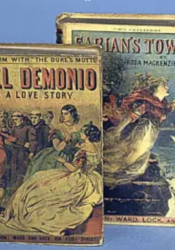The Book Trade- Altick's Main Ideas (Rebecca)
Books began to spread outside libraries as well, alongside the demand for reprints at lower prices. In 1855, “yellow-back” or railway novels became common occurrences in railroad stations. As train rides became longer, and their riders required entertainment, novels were provided to ensure their demands were met. W. H. Smith & Son was said to have monopolized this industry, establishing enticing book “concession stands” in almost every station across the country. These concession stands were said to draw in travelers with their illustrative advertisements and their varied reading materials, including books, newspapers, pamphlets, etc. Altick acknowledges the increased accessibility of books as a result of the development of book concession stands in saying, “No longer was it possible for people to avoid reading matter….” (301).
Fiction was not all that was being circulated in the early 1850s. John Cassell became the first individual to begin circulating educational materials in the same way novels were dispersed: in cheaper, divided parts. His most famous work, Popular Educator, which was released in 1852 proved to be a detrimental piece of educational material for many recognizable individuals at the time. Furthermore, Cassell introduced the idea that lower classes could gain access to information and education in a more casual, and ultimately cheaper, way. Illustrated, informational texts soon began to emerge, including examples like The Bible and The History of England.

